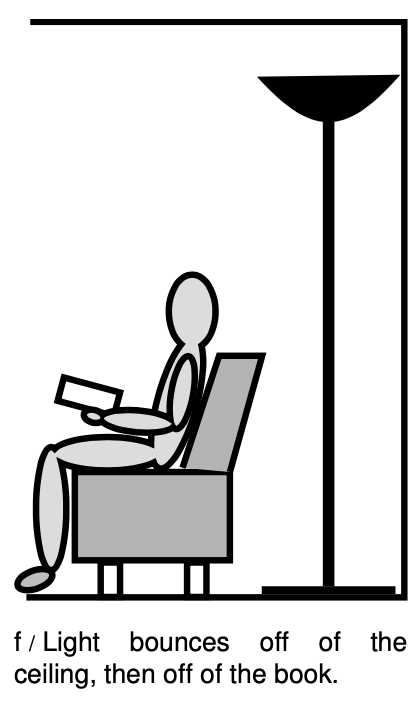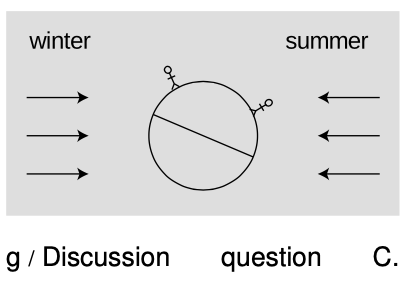28.2 Interaction of light with matter by Benjamin Crowell, Light and Matter licensed under the Creative Commons Attribution-ShareAlike license.
28.2 Interaction of light with matter
Absorption of light
The reason why the sun feels warm on your skin is that the sunlight is being absorbed, and the light energy is being transformed into heat energy. The same happens with artificial light, so the net result of leaving a light turned on is to heat the room. It doesn't matter whether the source of the light is hot, like the sun, a flame, or an incandescent light bulb, or cool, like a fluorescent bulb. (If your house has electric heat, then there is absolutely no point in fastidiously turning off lights in the winter; the lights will help to heat the house at the same dollar rate as the electric heater.)
This process of heating by absorption is entirely different from heating by thermal conduction, as when an electric stove heats spaghetti sauce through a pan. Heat can only be conducted through matter, but there is vacuum between us and the sun, or between us and the filament of an incandescent bulb. Also, heat conduction can only transfer heat energy from a hotter object to a colder one, but a cool fluorescent bulb is perfectly capable of heating something that had already started out being warmer than the bulb itself.
How we see nonluminous objects
Not all the light energy that hits an object is transformed into heat. Some is reflected, and this leads us to the question of how we see nonluminous objects. If you ask the average person how we see a light bulb, the most likely answer is “The light bulb makes light, which hits our eyes.” But if you ask how we see a book, they are likely to say “The bulb lights up the room, and that lets me see the book.” All mention of light actually entering our eyes has mysteriously disappeared.
Most people would disagree if you told them that light was reflected from the book to the eye, because they think of reflection as something that mirrors do, not something that a book does. They associate reflection with the formation of a reflected image, which does not seem to appear in a piece of paper.
 Imagine that you are looking at your reflection in a nice smooth piece of aluminum foil, fresh off the roll. You perceive a face, not a piece of metal. Perhaps you also see the bright reflection of a lamp over your shoulder behind you. Now imagine that the foil is just a little bit less smooth. The different parts of the image are now a little bit out of alignment with each other. Your brain can still recognize a face and a lamp, but it's a little scrambled, like a Picasso painting. Now suppose you use a piece of aluminum foil that has been crumpled up and then flattened out again. The parts of the image are so scrambled that you cannot recognize an image. Instead, your brain tells you you're looking at a rough, silvery surface.
Imagine that you are looking at your reflection in a nice smooth piece of aluminum foil, fresh off the roll. You perceive a face, not a piece of metal. Perhaps you also see the bright reflection of a lamp over your shoulder behind you. Now imagine that the foil is just a little bit less smooth. The different parts of the image are now a little bit out of alignment with each other. Your brain can still recognize a face and a lamp, but it's a little scrambled, like a Picasso painting. Now suppose you use a piece of aluminum foil that has been crumpled up and then flattened out again. The parts of the image are so scrambled that you cannot recognize an image. Instead, your brain tells you you're looking at a rough, silvery surface.
Mirror-like reflection at a specific angle is known as specular reflection, and random reflection in many directions is called diffuse reflection. Diffuse reflection is how we see nonluminous objects. Specular reflection only allows us to see images of objects other than the one doing the reflecting. In top part of figure d, imagine that the rays of light are coming from the sun. If you are looking down at the reflecting surface, there is no way for your eye-brain system to tell that the rays are not really coming from a sun down below you.
Figure f shows another example of how we can't avoid the conclusion that light bounces off of things other than mirrors. The lamp is one I have in my house. It has a bright bulb, housed in a completely opaque bowl-shaped metal shade. The only way light can get out of the lamp is by going up out of the top of the bowl. The fact that I can read a book in the position shown in the figure means that light must be bouncing off of the ceiling, then bouncing off of the book, then finally getting to my eye.
This is where the shortcomings of the Greek theory of vision become glaringly obvious. In the Greek theory, the light from the bulb and my mysterious “eye rays” are both supposed to go to the book, where they collide, allowing me to see the book. But we now have a total of four objects: lamp, eye, book, and ceiling. Where does the ceiling come in? Does it also send out its own mysterious “ceiling rays,” contributing to a three-way collision at the book? That would just be too bizarre to believe!
The differences among white, black, and the various shades of gray in between is a matter of what percentage of the light they absorb and what percentage they reflect. That's why light-colored clothing is more comfortable in the summer, and light-colored upholstery in a car stays cooler that dark upholstery.
Numerical measurement of the brightness of light
 We have already seen that the physiological sensation of loudness relates to the sound's intensity (power per unit area), but is not directly proportional to it. If sound A has an intensity of nW/m2, sound B is 10 nW/m2, and sound C is 100 nW/m2, then the increase in loudness from B to C is perceived to be the same as the increase from A to B, not ten times greater. That is, the sensation of loudness is logarithmic.
We have already seen that the physiological sensation of loudness relates to the sound's intensity (power per unit area), but is not directly proportional to it. If sound A has an intensity of nW/m2, sound B is 10 nW/m2, and sound C is 100 nW/m2, then the increase in loudness from B to C is perceived to be the same as the increase from A to B, not ten times greater. That is, the sensation of loudness is logarithmic.
The same is true for the brightness of light. Brightness is related to power per unit area, but the psychological relationship is a logarithmic one rather than a proportionality. For doing physics, it's the power per unit area that we're interested in. The relevant unit is W/m2. One way to determine the brightness of light is to measure the increase in temperature of a black object exposed to the light. The light energy is being converted to heat energy, and the amount of heat energy absorbed in a given amount of time can be related to the power absorbed, using the known heat capacity of the object. More practical devices for measuring light intensity, such as the light meters built into some cameras, are based on the conversion of light into electrical energy, but these meters have to be calibrated somehow against heat measurements.
Discussion Questions
A The curtains in a room are drawn, but a small gap lets light through, illuminating a spot on the floor. It may or may not also be possible to see the beam of sunshine crossing the room, depending on the conditions. What's going on?
B Laser beams are made of light. In science fiction movies, laser beams are often shown as bright lines shooting out of a laser gun on a spaceship. Why is this scientifically incorrect?
 C A documentary film-maker went to Harvard's 1987 graduation ceremony and asked the graduates, on camera, to explain the cause of the seasons. Only two out of 23 were able to give a correct explanation, but you now have all the information needed to figure it out for yourself, assuming you didn't already know. The figure shows the earth in its winter and summer positions relative to the sun. Hint: Consider the units used to measure the brightness of light, and recall that the sun is lower in the sky in winter, so its rays are coming in at a shallower angle.
C A documentary film-maker went to Harvard's 1987 graduation ceremony and asked the graduates, on camera, to explain the cause of the seasons. Only two out of 23 were able to give a correct explanation, but you now have all the information needed to figure it out for yourself, assuming you didn't already know. The figure shows the earth in its winter and summer positions relative to the sun. Hint: Consider the units used to measure the brightness of light, and recall that the sun is lower in the sky in winter, so its rays are coming in at a shallower angle.
28.2 Interaction of light with matter by Benjamin Crowell, Light and Matter licensed under the Creative Commons Attribution-ShareAlike license.